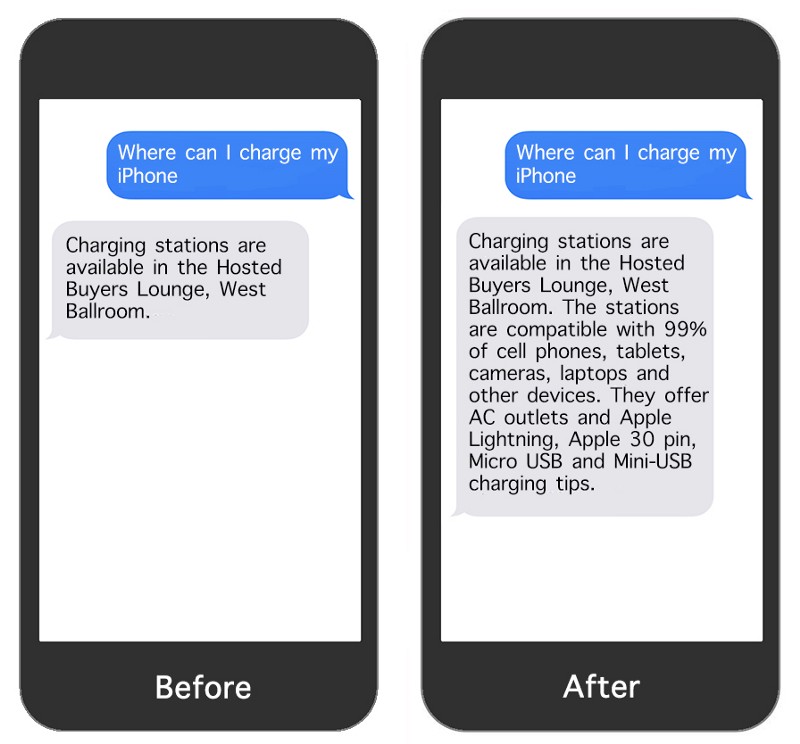In the last 10 years, chatbots have gained in popularity for event registration and customer service for conferences, trade shows and festivals, where they have proven they can instantly and accurately answer attendee questions 24/7—more reliably than human-powered responses.
If you are considering a chatbot for your event, here are five chatbot tricks and tips to help you understand and prepare for how to effectively use your new chatbot.
Chatbot Tips
Chatbot Tip #1 — It’s Like Hiring a New Team Member
Chances are pretty good you wouldn’t hire anyone new without defining their role and responsibilities. And once you’ve hired a new team member, you wouldn’t expect them to be successful and add value without training and mentoring.
Adding an event chatbot is no different. Think carefully about what you would like your bot to do. Do you need help with event registration? Boosting attendee experience? Address these kinds of questions with your chatbot vendor to determine what’s realistic in terms of scope, state of the technology and your budget. Then be prepared to work with your chatbot vendor to train and mentor your bot for success.
Chatbot Tip #2 — Content Makes the Conversation
The success of your chatbot is heavily dependent upon content. The good news is that your existing event content can be used as a source for your chatbot’s conversation. However, you should expect the following:
- Text messaging, the medium for your chatbot, is typically more concise, casual and conversational than your event website, festival guide or show program. Existing content must be re-worked, typically by your chatbot vendor, to be delivered effectively and conversationally by your chatbot.
- Existing content may not address what your attendees will ask your chatbot, so you may need to create new content or augment existing content with more detail, like this:

- Ensure your content uses consistent taxonomy (terms and phrasing). For example: don’t refer to the pre-event party as a Kick-off Party in one response and a Welcome Reception in another. It’s easier for users to understand inconsistent taxonomy when they are reading a website or guide because there is often more context. That’s not the case with chatbots. Your chatbot responses need to be concise and precise, so using consistent taxonomy will reduce confusion and meet users’ expectations.
Chatbot Tip #3 — Event Chatbots are Another Channel
Don’t forget to include your chatbot in your communications plan. If you are tweeting or posting about something that is part of your event, it’s likely that your bot will get asked questions about it. Ensure your bot’s conversation is as inclusive and up-to-date as your other channels.
Chatbot Tip #4 — Plan for Support
Your chatbot will get asked questions that it has not been trained to answer, so you need a plan for how to address these support requests. There are several human support options your chatbot can offer, depending upon the level of service you would like to provide for your event and the functionality your chatbot vendor supports.
- Your chatbot can respond with contact information, such as an email address and/or phone number that you will be monitoring. Your human support plan may differ before the event vs. during the event, so make this clear in your bot’s response.
- An attendee may want to use your chatbot to notify your team that they have a support request they would like addressed by a human. The human team can then take over for the bot and address the need.
- Even if offered, attendees may not follow up via a phone call, email or have the chatbot notify you. However, because you can monitor the conversations that attendees are having with your bot, you can provide support proactively by taking over for the bot.
Chatbot Tip #5 — Be Prepared to Hear the Voice of Your Customer
Your chatbot will get asked questions that you may not have thought of. You will also hear about issues that you didn’t know existed or become aware of them earlier because attendees are telling your bot instead of talking amongst themselves.
Chatbots make it possible for you to hear the voice of your customer, because you can monitor the conversations attendees are having with your bot in real-time or retrospectively. In addition, you can get alerts or view reports of the questions that your bot is unable to address. Some issues will make sense to address in real time at the event (i.e., adding signage, adjusting the audio system, updating your bot’s response with additional or clarifying details, etc.), while others can be reviewed afterward and considered as opportunities for improvement for future events.
Conclusion
Event chatbots are here to stay, and they are redefining the way we interact with our attendees. They’re opening up new opportunities to connect, engage, learn, support, and innovate. We hope these chatbot tips will help you make the most of what your chatbot can do for you and your event.
See How an Event Chatbot Can Level Up Your Event and Engage Your Audience in This E-Book.




.png?height=485&name=EventBots%20Facebook%20(1).png)